Ruger 57 5.7X28m4.94" 20rd, Turquoise – 16405 For Sale
$629.99
The Ruger 57 5.7X28mm, model 16405, is a high-performance firearm distinguished by its unique turquoise finish and advanced features aimed at reliability and precision. Central to its design is Ruger’s Secure Action fire-control system, which combines a protected internal hammer with a bladed-safety trigger for a smooth, precise shooting experience. Designed for ergonomic comfort, it includes an easy trigger reach, a 1911-style ambidextrous manual safety, a robust slide release, and a reversible magazine release, catering to both right- and left-handed users. The firearm boasts an alloy steel barrel with a black nitride finish for enhanced durability, and a billet steel slide with lightening cuts for reduced weight and improved handling. Its adjustable rear sight facilitates accurate targeting, and with a 4.94-inch barrel and a 20-round capacity, the Ruger 57 offers both style and high performance for discerning users.
Is a 5.7 more powerful than a 9mm?
The 5.7x28mm and 9mm (9x19mm Parabellum) are two different types of cartridges, each with its own characteristics.
1. **Velocity and Energy**:
– The 5.7x28mm typically has a higher velocity than the 9mm. This can result in a flatter trajectory and potentially better penetration, especially against certain types of armor.
– The 9mm generally delivers more energy upon impact due to its larger bullet size and mass.
2. **Bullet Size and Capacity**:
– The 9mm typically uses larger and heavier bullets, which can contribute to stopping power.
– The 5.7x28mm, being smaller, often allows for higher magazine capacities in a similarly sized firearm.
3. **Purpose and Application**:
– The 5.7x28mm is often used in contexts where defeating light body armor or needing higher capacity magazines is important.
– The 9mm is widely used for personal defense, law enforcement, and military applications due to its balance of power, recoil, and availability.
Overall, whether one is more “powerful” depends on the specific criteria and context—such as penetration, stopping power, or capacity—you are considering.
What is the 5.7 x28 good for?
The 5.7x28mm cartridge is known for a number of key characteristics and potential applications:
1. **Personal Defense**: The cartridge is often praised for its low recoil and high velocity, which can contribute to accuracy in self-defense scenarios.
2. **Military and Law Enforcement**: Originally developed for military applications, it is used in platforms like the FN P90 submachine gun and FN Five-seveN pistol. Its design aims to offer good penetration capabilities against body armor while maintaining manageable recoil.
3. **Compact Weapons**: Due to its small size and lightweight nature, the 5.7x28mm is suitable for use in compact firearms which can be advantageous for close quarter combat situations.
4. **High Magazine Capacity**: Firearms chambered in 5.7x28mm can often hold more rounds compared to those chambered in larger calibers of similar size, providing increased firepower without a significant increase in weight or size.
5. **Sport Shooting**: The round’s accuracy and flat trajectory make it attractive to some sport shooters, particularly in competitive settings where precision and recoil control are important.
6. **Hunting**: While not typically used for large game, it can be suited for small game hunting due to its velocity and terminal performance.
Overall, the 5.7x28mm is valued for its balance of speed, recoil management, and armor-piercing capability, making it versatile for various purposes including personal protection, law enforcement, and sport shooting.
Is the Ruger 57 good for self-defense?
The Ruger 57 can be a viable option for self-defense, but its suitability depends on personal preferences and specific needs. It is chambered for the 5.7x28mm cartridge, which offers high velocity and low recoil. This can provide good stopping power and allow for quick follow-up shots. However, the 5.7x28mm round may be less commonly available than more traditional self-defense calibers like 9mm. Additionally, the Ruger 57 is a full-sized handgun, which might be less convenient for concealed carry compared to more compact models. Ultimately, whether it is a good choice for you depends on factors like how comfortable you are with the firearm, your ability to handle it effectively, and your personal circumstances for self-defense.
Can a civilian own a FN-57?
Yes, a civilian can own an FN Five-seveN pistol in the United States, provided they meet state and federal regulations. This includes passing a background check, being of legal age, and complying with any specific state or local laws regarding handgun ownership. It’s essential to check the laws in your state, as regulations can vary.
Will 5.7 x28 stop a bear?
The 5.7x28mm cartridge is generally not recommended for stopping a bear. It is a small caliber, high-velocity round designed for personal defense and law enforcement use against human threats, not large, thick-skinned animals like bears. Bears are powerful animals with dense muscle and bone structure, and stopping a bear typically requires a larger caliber, more powerful round like those used in big-game hunting rifles, such as .30-06 Springfield or larger calibers like .375 H&H Magnum. In a dangerous bear encounter, it is always best to prioritize safety and use bear spray or larger, more appropriate weaponry if needed.
What caliber is a 5.7 x28 equivalent to?
The 5.7x28mm cartridge is roughly equivalent to a .22 caliber, specifically in terms of its bullet diameter. The bullet diameter of the 5.7x28mm is approximately 5.7 mm, which converts to about 0.224 inches, similar to the .223/5.56 NATO cartridges used in AR-15 rifles. However, the 5.7x28mm cartridge is designed for different applications and generally has different performance characteristics compared to these other calibers.
Will 5.7 penetrate body armor?
The ability of a 5.7x28mm round to penetrate body armor depends on several factors, including the type of ammunition used and the level of the body armor. Standard 5.7x28mm rounds, like those typically used in firearms such as the FN Five-seveN pistol or the FN P90, can penetrate lower-level body armor that is designed to stop handgun rounds. However, they may not penetrate higher-level body armor, such as those rated with NIJ Level III or IV protection, which are designed to stop rifle rounds.
Special armor-piercing variants of the 5.7mm exist, but their availability is often highly restricted to military and law enforcement. Always consider the specific ammunition type and the armor rating in question for a definitive answer.
What is the difference between a 223 and a 5.7 x28?
The .223 Remington and the 5.7x28mm are two different types of ammunition, designed for different platforms and purposes.
1. **.223 Remington**:
– Developed in the late 1950s and widely used in rifles, particularly the AR-15.
– Bullet Diameter: Approximately 5.56 mm (0.224 inches).
– Case Length: 45 mm.
– Overall Length: Approximately 57 mm.
– It is a centerfire rifle cartridge known for its high velocity, flat trajectory, and effective range.
2. **5.7x28mm**:
– Developed by FN Herstal in the late 1980s.
– Primarily used in firearms like the FN P90 submachine gun and FN Five-seven pistol.
– Bullet Diameter: Approximately 5.7 mm (0.224 inches).
– Case Length: 28 mm.
– Overall Length: Approximately 40.5 mm.
– Designed for use in personal defense weapons (PDWs) and offers features such as low recoil, high velocity, and armor-piercing capabilities (in some military versions).
**Key Differences**:
– **Purpose and Design**: The .223 Remington is primarily used for longer-range shooting and is more powerful, designed for rifles. The 5.7x28mm is designed for PDWs and pistols with a focus on controllability and close-quarters combat.
– **Size and Power**: The .223 Remington is a larger and more powerful cartridge with a longer case and overall length, offering greater range and stopping power. The 5.7x28mm is smaller, providing less power but is lighter with lower recoil.
– **Typical Platforms**: .223 is often used in rifles like the AR-15, while 5.7x28mm is used in specialized firearms like the FN P90 and FN Five-seven.
Each cartridge is optimized for different tactical needs and firearm designs.
How lethal is the 5.7 round?
The lethality of the 5.7×28mm round, developed by FN Herstal, is influenced by several factors, including the design of the bullet, the target, and the range at which it is fired.
1. **Design and Purpose**: The 5.7×28mm round was designed to offer a higher muzzle velocity and better penetration capabilities compared to traditional handgun calibers like 9×19mm Parabellum. This round is specifically designed to penetrate body armor, making it more effective in certain military and law enforcement scenarios.
2. **Penetration and Range**: The 5.7 round can penetrate body armor and has a flatter trajectory, which makes it effective at longer ranges compared to some other pistol calibers. Its ability to penetrate is partly due to its velocity and the design of its projectile.
3. **Stopping Power and Lethality**: While the 5.7 round can be very effective in penetrating targets, some argue that its stopping power might be less than larger caliber rounds. Lethality also depends on shot placement and the ability to hit vital organs. The high velocity can cause significant damage, but opinions on its effectiveness compared to larger, slower rounds vary.
Overall, the 5.7×28mm round is considered very lethal, especially in situations where penetration of armor is necessary. Its actual effectiveness can depend heavily on the specific context of its use.
What is more powerful than a 9mm?
The .40 S&W, .45 ACP, and 10mm Auto are examples of cartridges generally considered more powerful than the 9mm in terms of stopping power and energy.
How lethal is the 5.7 round?
The 5.7x28mm round, developed by FN Herstal, is known for its high velocity, flat trajectory, and ability to penetrate body armor, especially when using specific types of ammunition designed for military or law enforcement use. Its lethality is often debated and depends on several factors such as the type of bullet, the range, and the target.
The round is less powerful in terms of raw energy compared to larger calibers like the 9mm or .45 ACP, but its design provides certain tactical advantages. It can be quite effective against unarmored or lightly armored targets due to its high speed and potential to create significant internal damage. Nevertheless, its lethality can vary significantly depending on the specific circumstances of its use.
Why is the 5.7 mm so popular?
The 5.7×28mm cartridge is popular for several reasons:
1. **High Velocity and Flat Trajectory:** The 5.7×28mm has a high muzzle velocity, which allows for a flat trajectory over relatively long distances. This makes it effective for both short and medium-range engagements.
2. **Low Recoil:** The cartridge generates relatively low recoil compared to traditional pistol rounds and some larger calibers, making it easier to control during rapid or sustained fire.
3. **Armor Penetration:** Originally developed for military use, the 5.7×28mm is designed to penetrate body armor, giving it tactical advantages in military and law enforcement applications.
4. **High Magazine Capacity:** Firearms chambered for the 5.7×28mm often have higher magazine capacities due to the cartridge’s smaller size. This is beneficial for situations requiring substantial firepower.
5. **Versatility:** The cartridge can be used in a variety of firearms, including pistols and carbines, providing flexibility across different platforms.
6. **Popularity and Availability:** Increased interest and production have led to more availability and options in firearms chambered for this round, contributing to its popularity among civilian shooters, especially for those interested in personal defense, sport shooting, and collecting.
These factors combined make the 5.7×28mm an attractive option for various users, from civilian enthusiasts to professionals in military and law enforcement.
Is 5.7 bigger than 223?
No, 5.7 is not bigger than 223.
| Model | 57 |
|---|---|
| Action | Semi-Auto |
| Grips | Textured |
| Safety | Ambidextrous |
| Sights | Fiber Front & Adjustable Rear |
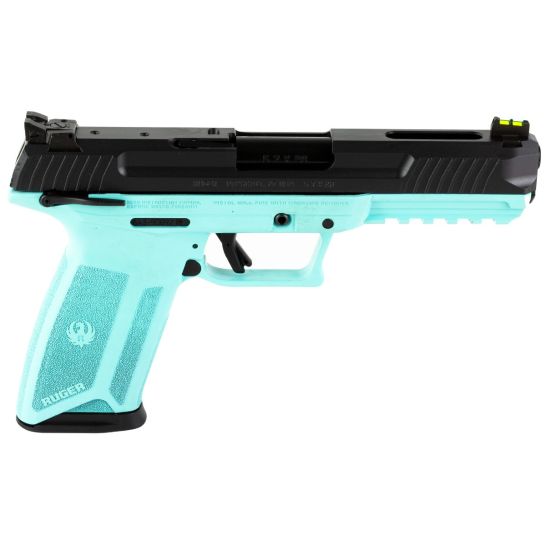
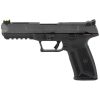
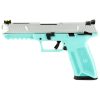
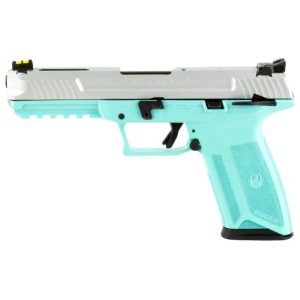
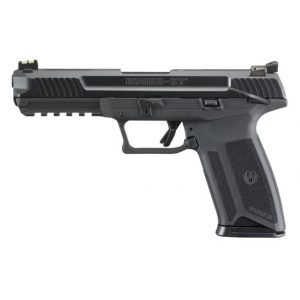
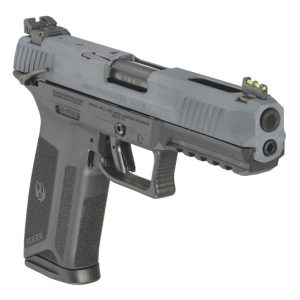
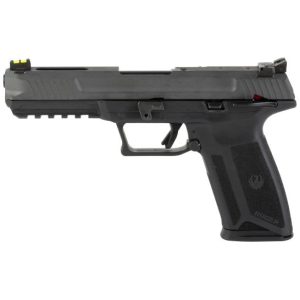
Reviews
There are no reviews yet.